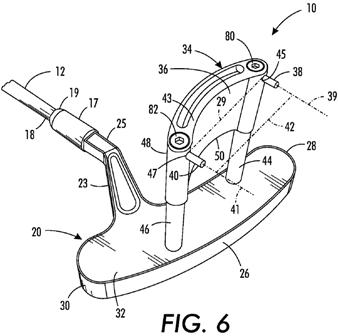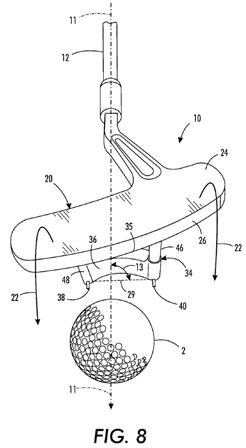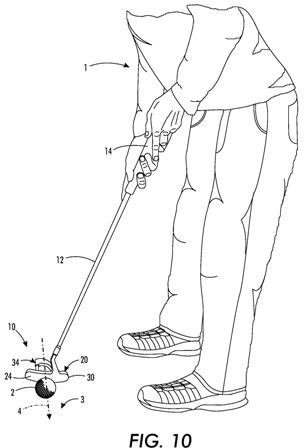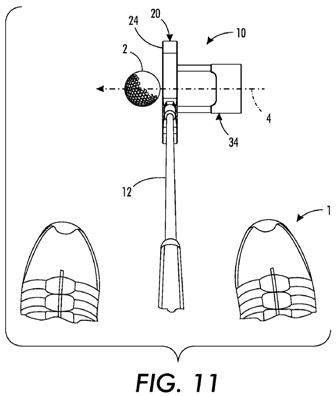Would it Work? Special Alignment Putter Edition
Sometimes the drawings in a patent just draw you in and make you want to learn “the rest of the story.” That was the case when I came across USPN 

The method of use of the applicant’s golf putter 10 will now be described, with reference in particular to FIGS. 7-11. Referring first to FIG. 7, the golfer 1 takes a position such that his ball 2 is on the green 3 between him, and the approximate target direction for his putt. He lowers himself by bending or squatting, and takes a line of sight down along the axis 11 of the shaft 12 of his putter 10, with his ball 2 along the line of sight. He holds the putter 10 with the distal end 14 of the shaft 12 in a lowered position, i.e. between approximately a “nine o’clock” and a “ten o’clock” position. The golfer 1 then observes the contour of the green 3 and chooses his “line” for the putt, which may be directly to the golf hole (not shown) if the green appears level, or which may be another direction to account for slope of the green 3. He aligns the shaft 12 of his putter 10 in the exact direction of his “line,” also with his ball 2 along this line, by sliding the putter 10 along the green 3 as needed. It is noted that at this point, the distal end 43 of the rearward member 34 is the portion of the club that is in contact with the green 3, and that this distal end 43 is provided with a smooth surface, to facilitate sliding the club 10 on the green 3, without snagging or damaging the grass of the green 3.

Referring now to FIG. 8, and FIG. 9 in sequence, the golfer 1 then proceeds to raise the distal (grip) end 14 of the shaft 12 of the putter 10 from the approximately nine o’clock/ten o’clock position, to a vertical, i.e., twelve o’clock position. As he raises the distal (grip) end 14 of the shaft 12, the face 24 of the club body tilts forward as indicated by arcuate arrows 22, and the cleats 38 and 40 sink and bite into the green 3, thereby preventing the club body 20 from slipping or twisting, and maintaining the alignment of the face 24 of the body in the transverse direction (see line segment 27 of FIG. 2) perpendicular to the putting line 4. As the club shaft 12 is pivoted upwardly, the two cleats 38 and 40, and the front edge 35 of the club body 20 may work as a tripod to provide further stability in this transition. When the putter shaft 12 is in the vertical position (FIG. 9), a portion of the lower surface 26 of the club body 20 is in contiguous contact with the green 3. Additionally, by virtue of the function of the cleats 38 and 40 during the transition of the club shaft 12 from angled to vertical, the front face 24 of the putter 10 is substantially perpendicular to the line 4 chosen by the golfer 1. This enables a more accurate putt. It is to be understood that the cleats 38 and 40 may not be as elongated and as sharp as shown in FIGS. 3-6. The cleats may be shorter, and may also have shapes other than cylindrical extending from the lower region 36 of the rearward member 34. The cleats 38 and 40 may be of various shapes, so long as they provide sufficient resistance to prevent the club body 20 from sliding on the green 3 during the transition of the club shaft 12 from the lowered position to the vertical position.

Referring to FIGS. 10 and 11, with the putter shaft 12 fully raised and vertical, the golfer 1 steps to the heel side of the putter 10. When he does this, the cleats 38 and 40 maintain a bite in the green 3, keeping the putter 10 in the desired alignment. The golfer 1 then grasps the grip 14 of the club shaft 12, and assumes a putting stance, moving the club shaft 12 slightly towards himself, thereby lowering the heel 30 of the club body 20 (as indicated by arrow 37 of FIG. 9) to a point such that the heel 30 is slightly lowered and the toe 28 is slightly raised, substantially as shown in FIG. 2. It is noted that the face 24 of the club body 20 is in the best position, i.e. it has been maintained substantially perpendicular to the chosen line 4 when the club shaft 12 is tilted to the correct putting position as shown in FIGS. 10 and 11.
Would this method help your alignment? I think it might, but you would have to listen to the commentary of your playing partners as you perform your pre-putt ritual. It just takes one guy on TV using it to become an overnight sensation.
Dave Dawsey – The Golf Attorney
PS – Check out more “Would it Work?” posts HERE


